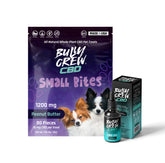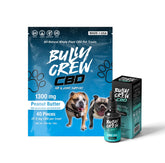If your dog struggles with separation anxiety, you know how heartbreaking it can be—for both of you. The moment you walk out the door, your pup is left feeling stressed, anxious, and uncertain. And as a pet parent, it's tough knowing they're in distress every time you leave.
Many dog owners are turning to CBD for curing dog separation anxiety. Hemp-derived CBD has gained attention for its calming properties, and for the first time, scientists have studied its effects specifically on canine separation anxiety. While research is still unfolding, pet parents have used CBD for years to help their dogs relax when left alone.
So, does CBD really work as dog medication for separation anxiety? How does it help? Is it safe, and how should you use it correctly? In this article, we'll explore everything you need to know about remedies for separation anxiety in dogs.
Separation Anxiety in Dogs
Dogs are social animals that thrive on companionship, so it's no surprise that some struggle when left alone. Separation anxiety is a condition where dogs experience intense stress and exhibit anxious behaviors when apart from their owners. While many pups adjust to short periods of solitude, others become overwhelmed, especially in unfamiliar environments or after changes in routine.
Unlike humans, dogs don't have a clear understanding of time or future events. When you walk out the door, your dog doesn't necessarily know that you'll be back, which can trigger panic and distress. This explains why some dogs whine, bark, chew, or pace when left alone—they're not acting out; they're genuinely worried. And when you finally return home? That over-the-top, tail-wagging excitement isn't just happiness—it's relief.
Recognizing how dogs perceive time and absence can help pet parents find better ways for treating separation anxiety in dogs. Whether through training, comforting routines, or natural calming aids, there are ways to help your furry friend feel more secure, even when you're not around.
Causes of Separation Anxiety in Dogs
Separation anxiety in dogs isn't just about missing their owners—it often stems from significant changes in their environment or routine. If your pup is suddenly acting distressed when left alone, one of these common triggers might be the cause:
-
Disruptions to Their Routine – Dogs thrive on consistency, so if their schedule suddenly changes—like a shift in your work hours or longer periods of alone time—it can leave them feeling anxious and insecure.
-
A New Guardian or Family – Being rehomed, abandoned, or adopted from a shelter can be a stressful experience for dogs. Adjusting to a new family or caregiver often leads to separation anxiety as they struggle to feel secure in their new environment.
-
Moving to a New Home – Just like humans, dogs need time to adapt to a new space. A change in surroundings can be overwhelming, making them more prone to anxiety when left alone.
-
A Missing Family Member – If a family member moves out, goes away for an extended period, or even passes away, your dog may experience distress due to the sudden absence of a familiar presence.
Symptoms of Separation Anxiety in Dogs
Separation anxiety in dogs can show up differently—some are obvious, while others are more subtle. Here are the most common signs:
-
Clingy Behavior – Your dog follows you everywhere, even to the bathroom.
-
Destructive Actions – Chewing furniture or damaging the door you left from.
-
Overexcited Greetings – Acting overly excited when you return home.
-
Loud Vocalization – Howling or barking, especially when you're leaving.
-
Urinating or Pooping in Unusual Places – Accidents in strange spots around the house.
Some less noticeable signs include:
-
Trembling, Whining, or Pacing – Nervous energy when alone.
-
Excessive Drooling – More saliva than usual.
-
Self-Harm – Licking, biting, or scratching themselves excessively.
-
Repetitive Movements – Engaging in obsessive behaviors.
-
Vomiting – Anxious dogs may throw up due to stress.
Helping Your Dog Feel Calm and Secure
Anxiety in dogs can be distressing, but with the right approach, you can help your furry friend feel more at ease. If your dog seems anxious, the first step is to consult a veterinarian. They can assess the situation, identify possible causes, and suggest a plan to reduce stress and discomfort. Here are a few effective home remedies for dog separation anxiety:
-
Identify and Remove Stress Triggers – Just like humans, dogs can become anxious due to certain triggers, such as loud noises, unfamiliar environments, or separation. A vet can help determine what's causing distress, and once identified, you can work on minimizing or eliminating these stressors.
-
Incorporate Daily Exercise – Physical activity is a natural stress reliever. Regular walks, playtime, and interactive activities can help release pent-up energy and reduce anxiety-related behaviors like excessive barking or chewing. Exercise also strengthens the bond between you and your dog, making them feel safer and more secure.
-
Create a Safe Haven – Some dogs need a quiet retreat to escape overwhelming situations. Setting up a cozy, comfortable space—like a designated room, crate, or corner with their favorite bed and toys—gives them a sense of security when they need to unwind.
Understanding separation anxiety medication for dogs: What You Should Know
If your dog struggles with anxiety, finding the right solution can feel overwhelming. While medication is an option, it's important to consider other methods first. Here's what you need to know:
-
Start with Behavioral Training – Before turning to medication, try behavioral therapies such as desensitization, counterconditioning, and creating a calm environment. These methods can often help reduce anxiety naturally.
-
Explore Natural Remedies – Many pet owners prefer to start with holistic options like CBD oil, pheromone diffusers, or calming supplements before considering pharmaceuticals. These alternative dog separation anxiety medications can provide relief without the need for prescription drugs.
-
Prescription medication for canine separation anxiety – If behavioral training and natural remedies aren't enough, your vet may recommend dog separation anxiety meds.
Some of the most commonly prescribed drugs for dogs' separation anxiety are:
-
Alprazolam (Xanax) – Helps with situational anxiety, like thunderstorms or fireworks.
-
Amitriptyline – An antidepressant that also helps with anxiety-related issues.
-
Buspirone – Best for mild anxiety and confidence-building in shy or fearful dogs.
-
Clomipramine (Clomicalm) – A common treatment for separation anxiety.
-
Dexmedetomidine (Sileo) – Specifically designed for noise-related anxiety.
-
Diazepam (Valium) – Helps with severe anxiety and panic attacks.
-
Fluoxetine (Reconcile/Prozac) – Often used for long-term anxiety management.
-
Lorazepam (Ativan) – Useful for short-term relief in stressful situations.
-
Paroxetine (Paxil) – Treats both anxiety and compulsive behaviors.
-
Sertraline (Zoloft) – Another antidepressant that can help with anxiety disorders.
If you're considering over-the-counter separation anxiety medication for dogs, always consult a veterinarian first. They can guide you toward the best treatment plan based on your dog's specific needs. Combining training and natural approaches like CBD can help your furry friend live a calmer, happier life.
Can CBD Help With Separation Anxiety in Dogs?
If your dog gets anxious when left alone, CBD might help them feel more at ease. Research and pet owners suggest that CBD has calming properties that can reduce stress and promote relaxation.
In a recent study, researchers tested CBD on dogs in two situations—being left alone in a familiar room and taking a short car ride. Some dogs received a 4 mg/kg dose of CBD, while others were given a placebo. The results showed that dogs who took CBD were noticeably less stressed, with some experiencing a significant drop in anxiety compared to the placebo group.
Beyond scientific studies, many pet owners have seen positive results firsthand. CBD doesn't make dogs high, but it helps them stay calm. Many pet parents also report fewer anxious behaviors, like excessive barking, chewing, or pacing, when using CBD as part of their dog's routine.
If your dog struggles with separation anxiety, CBD could be a natural way for curing dog separation anxiety. Be sure to consult your veterinarian to determine the right dosage and ensure it's a good fit for your pup.
How CBD Works in Dogs
Dogs, like humans, have an endocannabinoid system (ECS) that helps maintain balance in their bodies. This system is crucial in regulating mood, emotions, and overall well-being.
Unlike some compounds that directly bind to ECS receptors (CB1 and CB2), CBD works differently. Instead of attaching strongly to these receptors, it helps support the ECS's natural function. While studies in humans suggest CBD may prevent the breakdown of endocannabinoids, the exact way it works, especially in dogs, is still being researched.
By helping the body regulate itself, CBD may promote relaxation and emotional stability in dogs during stressful moments. However, every dog's ECS is unique, meaning the effects of CBD can vary. If you're considering trying CBD for your pup, consulting with your veterinarian is always a good idea.
Final Thoughts
If your dog struggles with separation anxiety, there are several remedies for separation anxiety in dogs. The best approach is to discuss a plan with your veterinarian to find what works best.
CBD oil is an exciting natural remedy gaining popularity in pet care, especially for anxiety relief. It interacts with your dog's endocannabinoid system to help promote relaxation and balance. Many pet owners have found it a safe and effective way to support their dog's well-being.
One of the easiest ways to give your dog CBD is through CBD-infused treats—since they're already used to snacks, they won't notice the difference! Plus, most dogs love them, making this a simple and stress-free way to help your furry friend feel more relaxed.







